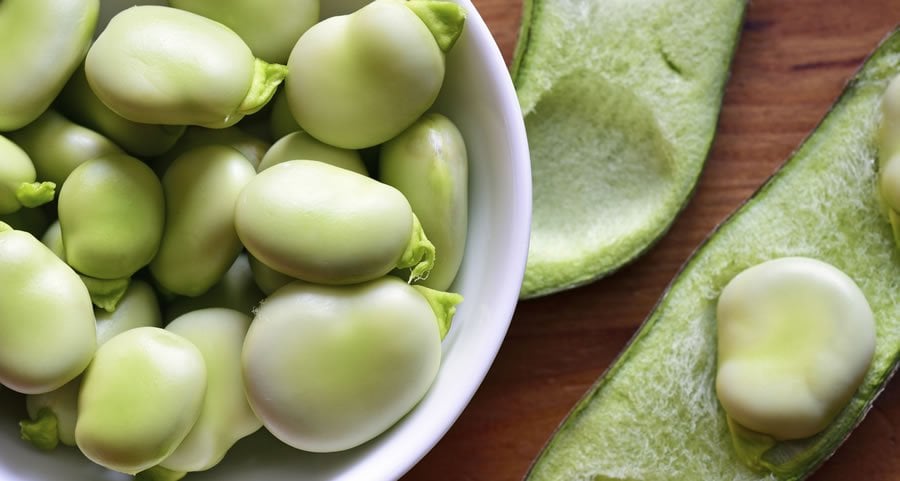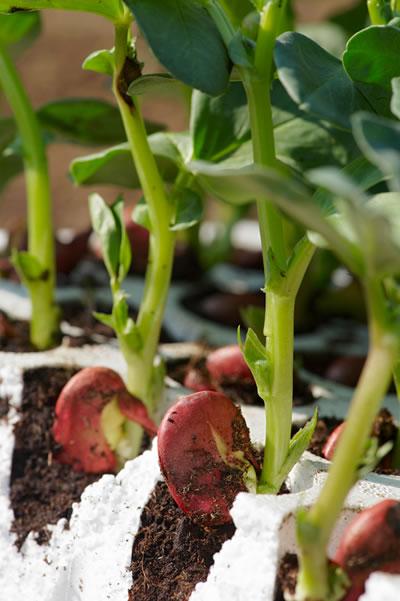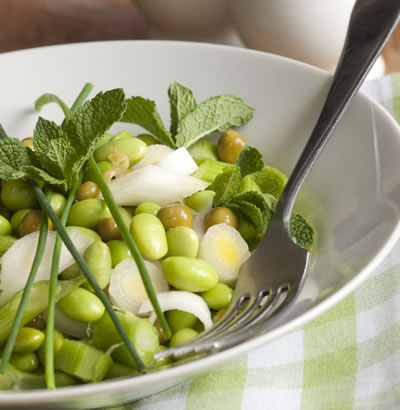It’s Fava Bean Season!
Get Nutrition Facts, Recipes & More
Crunchy and nutritious, fava beans are the Pritikin Longevity Center’s food of the month.

The History of Fava Beans
People have been eating fava beans since prehistoric times, and with good reason – according to the Center for Urban Education about Sustainable Agriculture (CUESA), favas, also known as broad beans, are adept at improving soil quality. In fact, old world farmers used them as a cover crop, planting their seeds in between other crops to achieve better soil nitrogen levels. Native to the Mediterranean region and southwestern Asia, favas are now grown in more than 50 countries worldwide.
Health Benefits of Fava Beans
“Favas are now grown in more than 50 countries worldwide.”
Research has shown that healthy diet plans rich in beans help maintain healthy cholesterol levels in the body. According to Harvard University, beans – such as favas – also feature high soluble fiber content. Fiber takes time to digest, which keeps you feeling full long after you've eaten. This causes you to consume less over the course of the day, leading to weight loss. Studies have also found that legume intake leads to longevity; even a three-quarter ounce increase in daily consumption can reduce your “mortality hazard ratio” by 7 to 8 percent! This is due, in part, to the fact that they're chock-full of nutrients like low-fat protein, vitamins, minerals and complex carbs, while also being low in sodium.
How to Buy Fava Beans in Season
When purchasing fresh favas at the market, look for young, tender beans with pods that are bright green in color, according to CUESA. The University of California, Davis' U.S. Small Farm Program stated that pods should also appear thick and have a glossy sheen. Most grocery stores carry these beans as they're popular among many ethnic groups. It's also possible to buy dried fava beans, although these are often salted, so be sure to steer clear if they are – too much dietary sodium can elevate blood pressure.

Fava Bean Season | Grow Your Own Fava Beans
The plant typically takes four to five months to mature and grows best at temperatures between 70 and 80 degrees Fahrenheit. If you live in the Northeast or the Midwestern part of the United States, you should break soil in early spring. Planting season for warmer climates is fall or winter. These hardy stalks require minimal maintenance, making them the perfect project for green thumbs who have a full work or social calendar.
How to Store Fava Beans
Pods can be kept for up to two weeks in an unsealed bag in the refrigerator. Don't separate the beans from their pods until you're ready to use them.
How to Prepare Fava Beans
Preparing fresh favas does require a bit of work, but the effort is well worth the reward. First you must remove the beans from their pod: Hold the pod in one hand and peel, or “shuck” with the other. Next, you should blanche the beans in boiling water and then drop them into a bowl of ice water in order to loosen the thick, white skin that surrounds each bean. Once the skins have been loosened, they'll be easy for you to peel off and discard. Your fava beans are now shelled, peeled and ready to cook.
Alternately, you can skip the shucking and peeling and instead roast your fresh favas. To do this, preheat your oven to 450 degrees F. Scatter the pods onto a nonstick baking sheet and bake for 20 minutes. Or, if you prefer to do your seasonal cooking outdoors, simply place the pods on a hot grill over medium-high heat and cook each side for about four minutes. There's no need to further prepare the pods – just put in a bowl and serve as a finger food. Both roasting and grilling impart a nice earthy flavor to the pods, which can be ripped open to unveil the buttery beans inside.
How to Eat Fava Beans
Fava beans can be enjoyed plain (as described above) or they can be incorporated into a number of dishes such salads, soups or dips. Here are some of our favorite ways to use the legume:

- Salad: Throw a handful of shelled beans on top of leafy greens; Favas pair well with onions, celery and fresh mint.
- Soup: Combine fava beans, white beans, any fresh vegetables, low-sodium chicken stock and chopped fresh parsley in a saucepan; Bring to a boil and simmer 15 minutes.
- Dip: Mash beans with water and chopped shallots; serve in a bowl alongside sliced cucumbers, radishes and celery.
- Side dish: Mix beans, halved cherry tomatoes, chopped green onions and fresh black pepper; top with vinegar.
- Main dish: Serve whole-wheat pasta with beans, asparagus, baby artichokes and mushrooms; add Pritikin all-purpose seasoning and a few sprigs of fresh mint.
Living well on the Pritikin Diet and Eating Plan means eating fresh, whole foods that fill you up, make you feel good and help your body run as it was intended to. By incorporating fava beans into your healthy eating plan this spring, your vitality will soar to new heights and your taste buds will thank you.